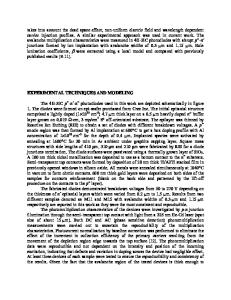Optical Characterization of Ion Implanted SIC
- PDF / 388,820 Bytes
- 6 Pages / 420.48 x 639 pts Page_size
- 79 Downloads / 358 Views
[1-5]. It has long been known that small metallic particles or colloids embedded in dielectrics produce colors associated with optical absorption at the surface plasmon resonance frequency [6,7]. For clusters with diameters much smaller than the wavelength of light (X), the theories of Mie [8] can be used to calculate the absorption coefficient (cm-') of the composite: 187rQn2
E2
S(l+2n
(1)
where Q is the volume fraction occupied by the metallic particles, no is the refractive index of the host medium, and E, and E2 are the real and imaginary parts of the frequency-dependent dielectric constant of the bulk metal. Equation 1 is a Lorentzian function with a maximum value at the surface plasmon resonance frequency (wp), where
+ 2n22 =0 =(co)
(2).
Values of E, for the metals as a function of wavelength are tabulated in [9] and the published index of refraction for SiC is 2.655. The index of refraction measured by prism 215 Mat. Res. Soc. Symp. Proc. Vol. 588 ©2000 Materials Research Society
coupling for the SiC used in this work was 2.26. From Equation (2) one can predict the photon wavelengths for the surface plasmon resonance frequencies for metallic colloids in the photorefractive host materials, as shown in Fig. 1. This figure shows that taking no = 2.7, the theoretical value of no for SiC, the absorption bands should be near 688 nm and 446 nm for Au and Sn colloids, respectively.
RESULTS Optical Absorption Figure 2 shows typical optical absorption spectra for 6H Al-doped SiC implanted with 160 keV Sn at room temperature and annealed at 200'C in argon for one hour. This figure also shows that as implantation fluence increases the absorption baseline increases. Using the experimentally determined absorption peak, 406 nm, the permittivity from Fig. 1, and equation (2), the calculated index of refraction for SiC at the implanted volume is 2.4. That this value is lower than the accepted value of n = 2.7 for SiC is almost certainly due to the implantation damage and disruption of the lattice [10]. Observation of the formation of Sn nanoclusters in SiC using visible optical photospectrometry was made possible because of the high index of refraction of the host material. Otherwise, the absorption band would have been located in the UV region. After heat treatment at 400'C and 600'C the peak at 406 nm disappeared. Figure 3 shows optical absorption spectrum for a 6H, N doped SiC sample implanted with 3 x 1017 Au/cm2 at 1.0 MeV and at a temperature of 500'C then and annealed at 10000 C in an argon ambient for one hour. Also shown is the absorption spectrum of the sample prior to implantation and the difference between the two. At Au fluences less than 3 x 10 17/cm 2 no peaks due to plasmon resonance were discernible. It is clear from the difference spectrum that significant implantation damage remains after the heat treatment. Similar effects were observed in 6H, N-doped SiC, as shown in Fig. 4. The peak was at 535 nm after heat treatment at 1100 0 C in air. The peak was expected to appear in 0 the range of 630 to
Data Loading...










